Позакласний захід "Welcome to Great Britain"
Позакласний захід з англійської мови, де у формі подорожі учні поглиблюють знання про історичні пам'ятки, географічне розміщення, культуру та мистецтво Великої Британії. Матеріали краще підійдуть для старшокласників.
Викладач англійської мови
Полтавського професійного ліцею сфери послуг
Гречковська Тетяна Сергіївна
Позакласний захід з англійської мови. Віртуальна подорож до Великої Британії
“A Tour around Great Britain and Northern Ireland”
Мета: підвищувати інтерес учнів до культури народу, мова якого вивчається, знайомити з визначними місцями Великої Британії; розвивати навички усного мовлення; виховувати в дітей почуття дружби та поваги до інших народів, самоповагу та взаємоповагу.
Обладнання: стінгазети, інформаційні буклети, куточок з атрибутами Великої Британії, мультимедійна презентація, відеофрагмент, записи пісень.
Захід проводиться англійською мовою з частковим перекладом українською (презентація)
Підготовча робота: пошук інформації, виконання проектних робіт (презентації, плакати, стінгазети,буклети).
Хід виховного заходу
Teacher. Hello everybody! Glad to see you! Ladies and gentlemen! Welcome to Albion, where according to Bernard Shaw the mist is considered to be good weather, the rain is considered to be the fog, and the shower is said to be the rain. The Sun there looks like the Moon, and the Moon looks like cheese.
Well, I suppose, you know that Great Britain is often called “the Foggy Albion”. As far as I can guess, “foggy” due to the famous English fogs. What does “Albion” mean?
In the first century Before Christ the Romans who invaded England called it the Albion (meaning “white”) because of white cliffs of Dover (the chalk banks of the coast between France and England). Although “Albion” was purely a descriptive saying made in 55 BC by Julius Caesar, yet the name remains.
So, we invite you to the exciting tour round this interesting country. As you know the UK consists of 4 parts: England, Scotland, Wales and Northern Ireland.
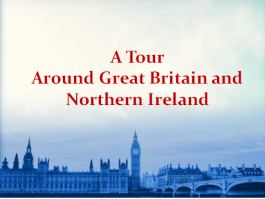
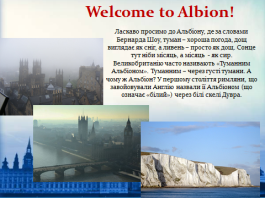
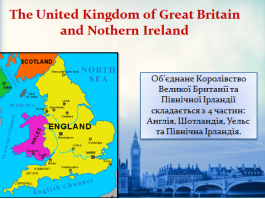
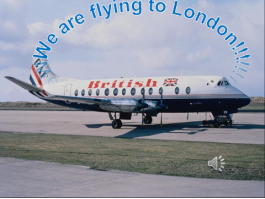
England
Guide 1. You are welcome to England the heart of Britain. It is a southeastern part of the country. England is the richest, the most fertile and industrial part of the country. Of the four parts which make up Great Britain it is the largest and most densely populated part. Over 46 of 57 million people of the United Kingdom live in England. The coasts of England are washed by The North Sea, the Irish Sea and the English Channel. No part of England is more than 120 kilometres from the sea.
London is one of the world's top tourist destinations, attracting upward of 15 million visitors each and every year.
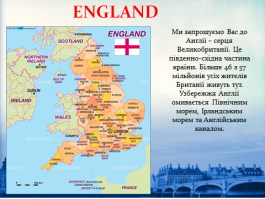
Guide 2. Buckingham Palace and the Changing of the Guard
One of Britain's most iconic buildings, Buckingham Palace is also the scene of London's most popular display of pomp and circumstance, the Changing of the Guard. Buckingham Palace was built in 1837 and has been the London residence of the Royal Family since Queen Victoria's accession. If you're wondering whether the Queen is in, look at the flagpole atop the building: if the royal standard is flying day and night, she's at home.
When she's away at her summer palace in Scotland, visitors can tour of the State Rooms, the Queen's Gallery, and the Royal Mews.
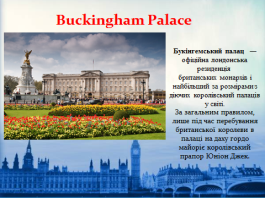
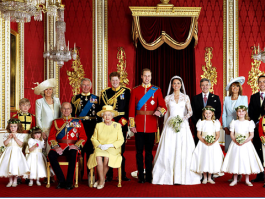
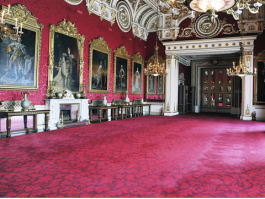
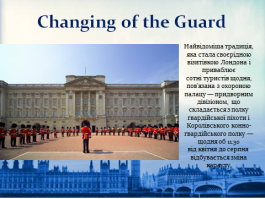
Guide 1. The British Museum
Displaying one of the world's finest collections of antiquities, the British Museum contains more than 13 million artifacts from the ancient world. With priceless objects from Assyria, Babylonia, China, Europe, and elsewhere, it's hard to know where to begin.
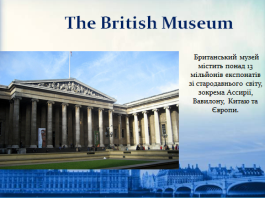
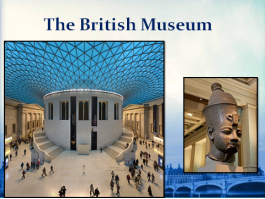
Guide 2. The Tower of London and Tower Bridge
From prison to palace, treasure vault to private zoo, the magnificent Tower of London has fulfilled many different roles through the centuries. One of Britain's most iconic structures, this spectacular World Heritage Site offers hours of fascination for visitors curious about the country's rich history - after all, so much of it happened here. Inside the massive White Tower, built in 1078 by William the Conqueror, is the 17th-century Line of Kings with its remarkable displays of royal armaments and armor. Other highlights include the famous Crown Jewels exhibition, the Beefeaters, the Royal Mint, and gruesome exhibits about the executions that took place on the grounds. The adjacent Tower Bridge, its two huge towers rising 61 meters above the River Thames, is one of London's best-known landmarks.
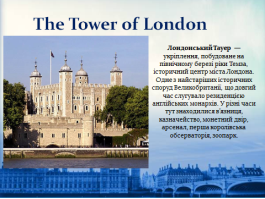
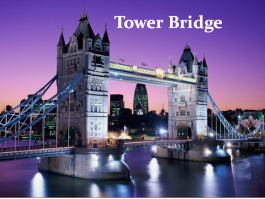
Guide 1. Big Ben and Parliament
Nothing says "London" more emphatically than the 97-meter tower housing the giant clock and its resounding bell known as Big Ben. It's as iconic a landmark as Tower Bridge. The tolling of Big Ben is known throughout the world as the time signal of BBC radio. Below it, stretching along the Thames, are the Houses of Parliament, seat of Britain's government for many centuries and once the site of the royal Westminster Palace occupied by William the Conqueror. Tours of the parliament buildings offer a unique chance to see real-time debates and lively political discussions. From Parliament Square, Whitehall is lined by so many government buildings that its name has become synonymous with the British government.
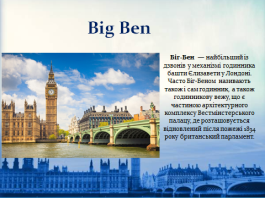
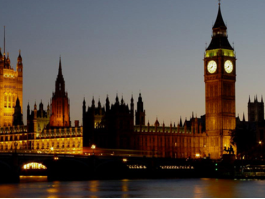
Guide 2. Westminster Abbey
Another location with a long association with British royalty, Westminster Abbey stands on a site that's been associated with Christianity since the early 7th century. Officially known as the Collegiate Church of St Peter in Westminster, Westminster Abbey was founded by Edward the Confessor in 1065 as his place of interment. From his burial in 1066 until that of George II almost 700 years later, most sovereigns were not only crowned here but they were buried here too. More recently, it's become famous as the preferred location for Royal Weddings.
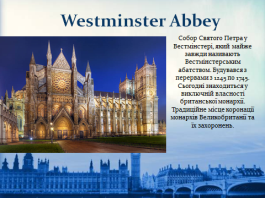
Guide 1. The London Eye
Built to mark London's millennium celebrations in 2000, the London Eye is Europe's largest observation wheel. Its individual glass capsules offer the most spectacular views of the city as you embark on a circular tour rising 135 meters above the Thames. The journey lasts 30-minutes.
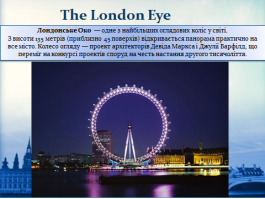
Guide 2. Piccadilly Circus and Trafalgar Square
Two of London's best-known tourist spots, these famous squares lie not far apart and mark the gateways to Soho, London's lively theater and entertainment district. Trafalgar Square was built to commemorate Lord Horatio Nelson's victory over the French and Spanish at Trafalgar in 1805. Nelson's Column, a 56-meter granite monument, overlooks the square's fountains and bronze reliefs, which were cast from French cannons. Admiralty Arch, St Martin-in-the-Fields, and the National Gallery surround the square. Piccadilly Circus marks the irregular intersection of several busy streets - Piccadilly, Regent, Haymarket, and Shaftesbury Avenue.
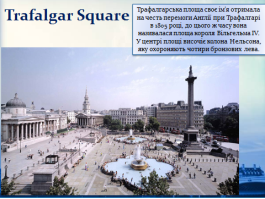
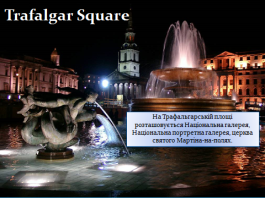
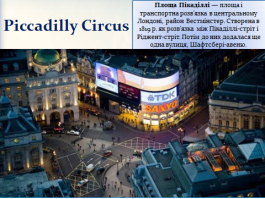
Guide 1. St Paul's Cathedral
The largest and most famous of London's many churches - and undoubtedly one of the most spectacular cathedral's in the world - St Paul's Cathedral sits atop the site of a Roman temple.
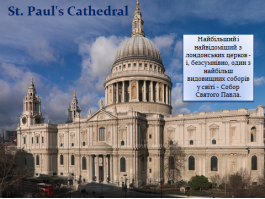
Guide 2. National Gallery
Ranking among the top art museums in the world, London's National Gallery represents an almost complete survey of European painting from 1260 until 1920. Among its highlights are a cartoon (preliminary sketch) of the Madonna and Child by Leonardo da Vinci, Michelangelo's The Entombment, Botticelli's Venus and Mars, van Gogh's Sunflowers, and The Waterlily Pond by Monet.
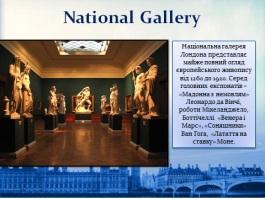
Guide 1. Madame Tussaud´s Wax Museum
Madame Tussaud´s Wax Museum is one of London's most famous museums. First begin in 1835, the museum brings well-known figures from history and modern culture to life with stunningly-realistic figures made from wax. It features figures from politics, entertainment, royalty and history in an enormous museum grouped into several large, themed exhibits. From world leaders to famous murderers, the various themed rooms have plenty of figures to keep visitors busy for hours.
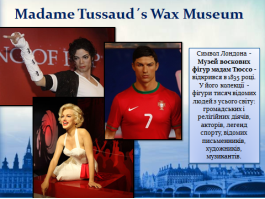
Guide 2. And of course we must mention about these legendary musicians. The Beatles were an English rock band, started in Liverpool, England in 1960. They were, and still are, one of the most successful and influential bands in the history of modern music.
(Виконання пісні “Let It Be” Бітлз).
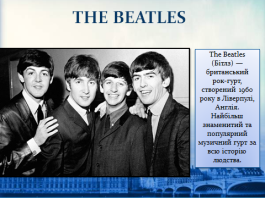
Scotland
Guide 3. Now you are welcome to the other beautiful and picturesque part of the United Kingdom. Many artists depicted Scotland in their works and many poets sang the praise of it.
Scotland forms the northern part of Great Britain, including the islands of the Hebrides, Orkney and Shetland. The population of Scotland is a little over 5 million people.
Guide4. Scotland is a very mountainous country: three-fourth of the area of Scotland is occupied by mountains. Scotland is famous for its beautiful large lakes with mountains round them. There are many rivers in Scotland, but they are not long. The longest and the most important Scottish river is the Clyde.
Guide 3. Scotland is divided into three regions: the Highlands, the northern and the most underpopulated area with a harsh climate, the Lowlands, the most industrial region, where live about three quarters of the population, and the Southern Uplands, with hills, which border on England.
The Highlands of Scotland are among the oldest mountains in the world. They reach the highest point in Ben Nevis. Many valleys between the hills are filled with lakes, called lochs. The best-known is Loch Ness. The most important city here is Aberdeen which is the oil centre of Scotland.
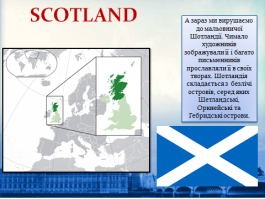
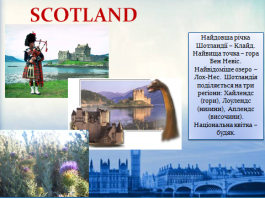
Guide 4. Well… When I see so beautiful places I can’t but remember the poem of the famous Scottish poet Robert Burns.
My heart’s in the Highlands. (R. Burns)
My heart’s in the Highlands, my heart is not here,
My heart’s in the Highlands a-chasing the deer,
A-chasing the wild deer and fallowing the roe -
My heart’s in the Highlands, wherever I go!
Farewell to the Highlands, farewell to the North,
The birthplace of valour, the country of worth!
Wherever I wander, wherever I rove,
The hills of the Highlands for ever I love.
Farewell to the mountains high covered with snow,
Farewell to the straths and green valleys below,
Farewell to the forests and wild-hanging woods,
Farewell to the torrents and long-pouring floods!
My heart’s in the Highlands, my heart is not here,
My heart’s in the Highlands a-chasing the deer,
A-chasing the wild deer and fallowing the roe -
My heart’s in the Highlands, wherever I go!
Guide 3. The national flower of Scotland is the thistle. The national dress of Scotland is a kilt with shirt, waistcoat and tweed jacket.
There are a million ways to fill your holiday in Scotland with many things to see and do. Step on board a historic boat, take a train ride through a former film set, or taste stunning local food and drink - there are many places to visit in Scotland, whatever your interest.
Guide 4. National Museum of Scotland
Set on Edinburgh’s Chambers Street, this museum is a treasure trove of ancient artefacts and precious objects. It’s the most popular attraction in the UK outside of London and offers a great, year-round programme of temporary exhibitions.
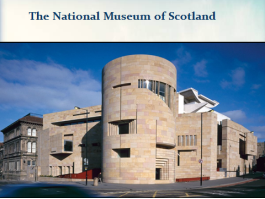
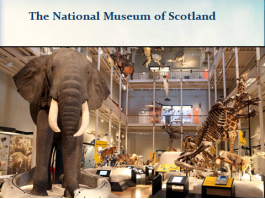
Guide 3. Edinburgh Castle
Edinburgh Castle is a true icon of Scotland and has dominated the skyline of the capital for centuries. Unusually, it’s set atop of an extinct volcano. It takes the title as Scotland’s most-visited paid-for attraction.
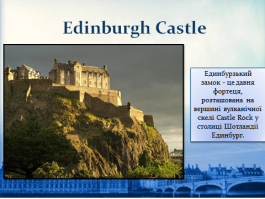
Guide 4. Kelvingrove Art Gallery & Museum
You’ll want to keep coming back to this museum time and time again. Set next to a classic Victorian park by the River Kelvin in Glasgow’s west end, it houses a staggering 8,000 objects in over 22 beautiful galleries.
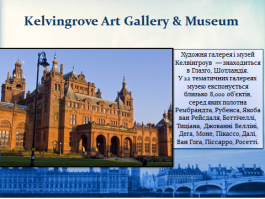
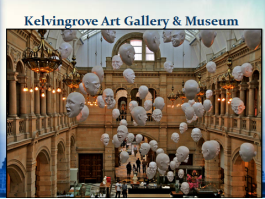
Guide 3. St Giles’ Cathedral
Located halfway down the historic Royal Mile, the framed crown spire of St Giles’ Cathedral is one of the most recognizable features of Edinburgh skyline.
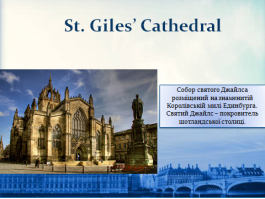
Guide 4. Scottish National Gallery
The gallery houses Scotland’s national collection of fine art from the early Renaissance to the end of the 19th century. The walls are adorned by masterpieces, from Raphael, Velázquez and Vermeer to Monet, Cézanne and Van Gogh, as well as works of Scottish artists.
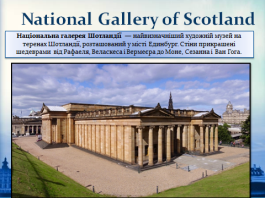
Guide 3. Riverside Museum
Opened in 2011, the spectacular Riverside Museum sits on the River Clyde and is home to the Glasgow Museum of Transport. It is full of fascinating objects and vehicles which tell the story of Scotland’s past and present.
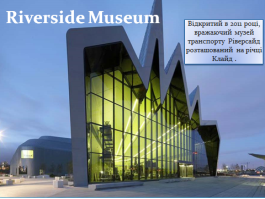
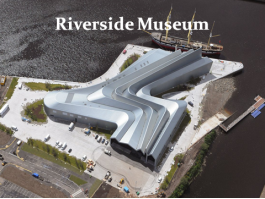
Wales
Guide 8. You are welcome to Wales.
Wales is a small country, its population is about 3 million people. The capital of Wales is Cardiff and its symbol is a daffodil. Wales is known by 800-year-old festival of Welsh music. It is called Eisteddfod.
Wales is a mountainous country with old hard rocks. It has two big busy ports of Liverpool and Bristol.
Guide 7. Over 20% of people in Wales speak Welsh language. They are fond of music, singing, poetry and drama. The Welsh people are very proud of their country and they still wear their national dress on holidays.
Wales has its own flag called the Welsh dragon.
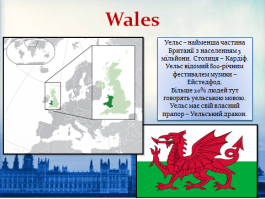
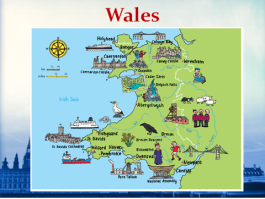
Guide 8. Snowdonia
Think of Wales, and you'll likely think of Snowdonia, the beautiful range of mountains and hills located in the county of Gwynedd. Consisting of 14 majestic peaks over 3,000 ft high - the most famous being the 3,546 ft Snowdon (the summit of which is accessible by train) - Snowdonia can be seen as far away as Porthmadog on the west coast. When you're there, it's easy to see why the area has featured so heavily in local legends, including those based around King Arthur, who locals will insist was Welsh.
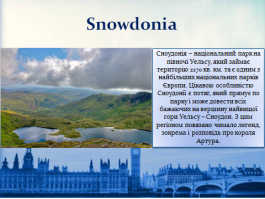
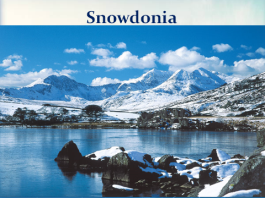
Guide7. Wales by Rail
Wales was once famous for its mining operations, in particular of the slate used for the roofing still so common here. While the majority of these mines and quarries have closed, the narrow-gauge railways used to shift goods around the country have been restored and now provide a fun means of getting about. Wales boasts more than 10 heritage railway lines, and it's now possible to take in many of the most popular landmarks, whether mountains, seaside towns or castles, simply by jumping on a steam train. Many of the bigger lines, such as the 14 mile-long Ffestiniog Railway running through Snowdonia National Park, offer unique train driving courses and volunteer opportunities to add to the experience.
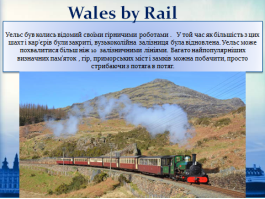
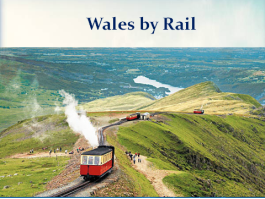
Guide 8. Caernarfon Castle
Built by King Edward I in the 13th Century as a seat for the first Prince of Wales, Caernarfon Castle is one of the largest castles in the country. With its 13 towers and two gates, this massive castle is recognized as one of the most impressive and best-preserved medieval fortresses in Europe. Occupying the site of an even older Norman castle, Caernarfon Castle dominates the waters of the River Seiont and the Menai Strait on one side, and is protected by a moat on the other. Its royal heritage continues to this day, and in 1969 was the scene of Prince Charles's investiture as Prince of Wales.
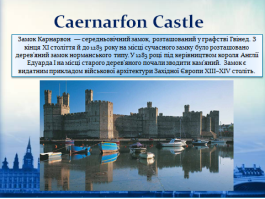
Guide 7. Anglesey
Separated from mainland Wales by the mile-wide Menai Strait - spanned by the Menai Suspension Bridge (1818) - the Isle of Anglesey is home to a number of quaint small fishing villages sprinkled along its more than 100 miles of attractive coastline. Along with its sandy beaches and landmarks such as South Stack Lighthouse, the island's mild climate makes it popular for day-trippers and campers alike. The smaller Holy Island, linked to Anglesey by bridge, is a popular holiday resort with two promenades, while tiny Salt Island offers great views and a chance for some bird watching. Finally, one of the world's most famous photo ops is on the railway platforms of the town with the world's longest place name: Llanfairpwllgwyngyllgogerychwyrndrobwllllandysiliogogogoch.
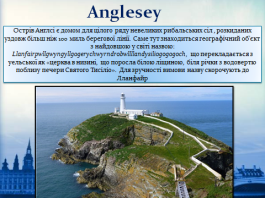
Northern Ireland
Guide 5. We’d like to visit the last part of the country, Northern Ireland.
As you probably know, Ireland is the second largest of the British Isles lying in the Atlantic off the west coast of Great Britain. The island of Ireland is politically divided into two parts: Northern Ireland, which forms part of the United Kingdom of Great Britain and the Republic of Ireland.
Guide 6. Northern Ireland has a population of about 1,5 million. It occupies 1/5 of the island of Ireland. This is a land of blue mountains and forest parks, mazy lakes and windswept moors, white Atlantic sands, an inland sea. In fact, it's a country that is just pretending to be small. Dozens of small towns are hidden away down among the green places of the countryside, and fishing villages string out along the shores.
Guide 5. Northern Ireland is surrounded by the sea to the north and east. The outstanding feature of the Irish weather is its changeability. Extremely high or low temperatures are unknown. The Irish Sea also has some influence in winter. There is an old Irish saying that Ireland must be the cleanest place in the world, because God washes it every day. Its capital city is Belfast. It is the leading industrial center and a large port.
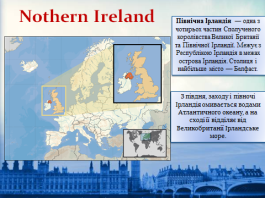
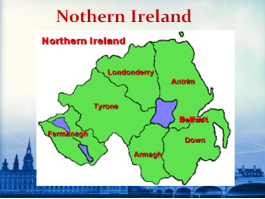
Guide 6. Londonderry/Derry City
The first records of Derry city date back to the 6th century, making it one of the longest inhabited places in Ireland. Originally the site of a monastery founded by one of the great Irish saints Saint Columba (Columcille), it has now evolved into one of Northern Ireland’s great cities.
Derry/Londonderry or the Walled City is steeped in heritage and history with a number of key events, which have made it the fantastic city it is today – a blend of the modern and historic with some of the most positive locals you’ll ever meet.
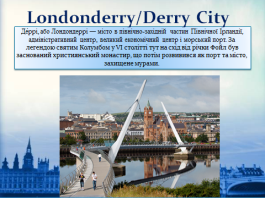
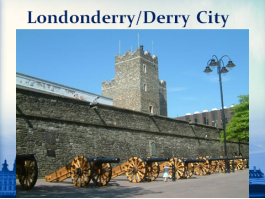
Guide 5. The Causeway Coast
The Giant's Causeway is an area of about 40,000 interlocking basalt columns, the result of an ancient volcanic eruption.
It is located in County Antrim on the northeast coast of Northern Ireland, about three miles (4.8 km) northeast of the town of Bushmills. It was declared a World Heritage Site by UNESCO in 1986, and a national nature reserve in 1987 by the Department of the Environment for Northern Ireland.
According to legend, the columns are the remains of a causeway built by a giant. The story goes that the Irish giant Fionn mac Cumhaill (Finn MacCool), from the Fenian Cycle of Gaelic mythology, was challenged to a fight by the Scottish giant Benandonner. Fionn accepted the challenge and built the causeway across the North Channel so that the two giants could meet.
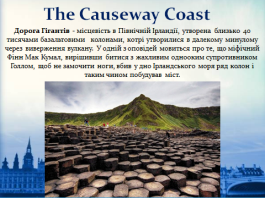
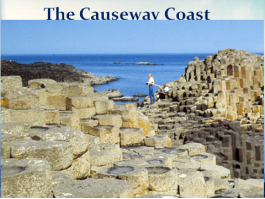
Guide 6. Titanic Belfast
Titanic Belfast is a visitor attraction and a monument to Belfast's maritime heritage on the site of the former Harland & Wolff shipyard in the city's Titanic Quarter where the Titanic was built. It tells the stories of the ill-fated Titanic, which hit an iceberg and sank during her maiden voyage in 1912, and her sister ships Olympic and Britannic.
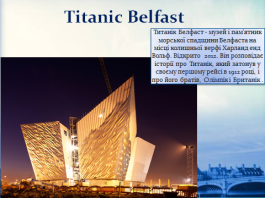
(Учні виконують пісню Celine Dion “My heart will go on”).
Teacher. So, our trip has come to its end. We well know that there is so much to see in Great Britain, that even the British can always find new places of interest to discover. And it’s impossible to discuss all of them for such a short period. We’ll do it next time.
Travel, enjoy your life, dream and love!
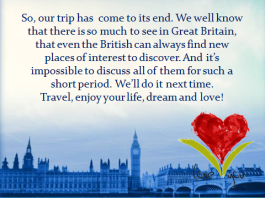
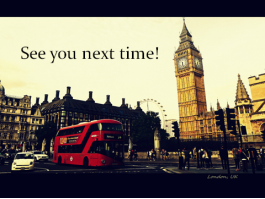


про публікацію авторської розробки
Додати розробку
